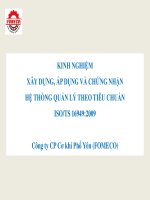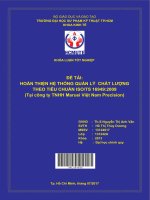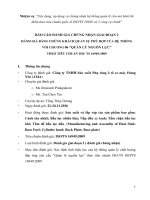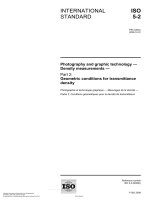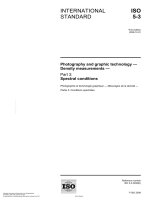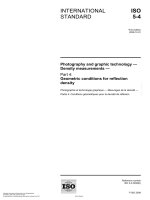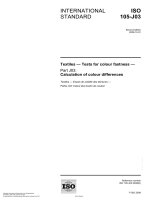Tiêu chuẩn iso 01452 3 2009 (2010)
Bạn đang xem bản rút gọn của tài liệu. Xem và tải ngay bản đầy đủ của tài liệu tại đây (569.08 KB, 43 trang )
INTERNATIONAL
STANDARD
ISO
1452-3
First edition
2009-12-01
Corrected version
2010-03-01
Plastics piping systems for water supply
and for buried and above-ground
drainage and sewerage under pressure —
Unplasticized poly(vinyl chloride)
(PVC-U) —
Part 3:
Fittings
Systèmes de canalisations en plastique pour l'alimentation en eau, pour
branchements et collecteurs d'assainissement enterrés et aériens avec
pression — Poly(chlorure de vinyle) non plastifié (PVC-U) —
Partie 3: Raccords
Reference number
ISO 1452-3:2009(E)
© ISO 2009
ISO 1452-3:2009(E)
PDF disclaimer
This PDF file may contain embedded typefaces. In accordance with Adobe's licensing policy, this file may be printed or viewed but
shall not be edited unless the typefaces which are embedded are licensed to and installed on the computer performing the editing. In
downloading this file, parties accept therein the responsibility of not infringing Adobe's licensing policy. The ISO Central Secretariat
accepts no liability in this area.
Adobe is a trademark of Adobe Systems Incorporated.
Details of the software products used to create this PDF file can be found in the General Info relative to the file; the PDF-creation
parameters were optimized for printing. Every care has been taken to ensure that the file is suitable for use by ISO member bodies. In
the unlikely event that a problem relating to it is found, please inform the Central Secretariat at the address given below.
COPYRIGHT PROTECTED DOCUMENT
© ISO 2009
All rights reserved. Unless otherwise specified, no part of this publication may be reproduced or utilized in any form or by any means,
electronic or mechanical, including photocopying and microfilm, without permission in writing from either ISO at the address below or
ISO's member body in the country of the requester.
ISO copyright office
Case postale 56 • CH-1211 Geneva 20
Tel. + 41 22 749 01 11
Fax + 41 22 749 09 47
Web www.iso.org
Published in Switzerland
ii
© ISO 2009 – All rights reserved
ISO 1452-3:2009(E)
Contents
Page
Foreword ............................................................................................................................................................iv
Introduction.........................................................................................................................................................v
1
Scope ......................................................................................................................................................1
2
Normative references............................................................................................................................2
3
3.1
3.2
Terms, definitions, symbols and abbreviated terms .........................................................................3
Terms and definitions ...........................................................................................................................3
Symbols..................................................................................................................................................3
4
4.1
4.2
4.3
Material ...................................................................................................................................................3
Fitting material .......................................................................................................................................3
Density....................................................................................................................................................3
MRS-value ..............................................................................................................................................4
5
5.1
5.2
5.3
General characteristics.........................................................................................................................4
Appearance ............................................................................................................................................4
Colour .....................................................................................................................................................4
Opacity of fittings intended for the above-ground conveyance of water........................................4
6
6.1
6.2
6.3
6.4
6.5
6.6
6.7
6.8
Geometrical characteristics .................................................................................................................4
Measurement of dimensions ................................................................................................................4
Nominal diameters ................................................................................................................................4
Fittings for solvent cementing .............................................................................................................4
Adapter fittings ....................................................................................................................................12
Tapping saddles ..................................................................................................................................14
Flange adapters and flanges ..............................................................................................................17
Elastomeric ring seal fittings .............................................................................................................20
End-load-bearing double-sockets with elastomeric seals ..............................................................29
7
7.1
7.2
7.3
Classification and operating conditions ...........................................................................................29
Classification .......................................................................................................................................29
Selection of nominal pressure and pipe series S for water up to and including 25 °C ...............29
Determination of the allowable operating pressure for water up to 45 °C ....................................30
8
8.1
8.2
Mechanical characteristics.................................................................................................................30
Resistance to internal pressure of fittings or parts of fittings .......................................................30
Crushing test .......................................................................................................................................31
9
Physical characteristics......................................................................................................................31
10
Sealing rings ........................................................................................................................................32
11
Adhesives.............................................................................................................................................32
12
Performance requirements.................................................................................................................32
13
13.1
13.2
13.3
Marking .................................................................................................................................................32
General .................................................................................................................................................32
Minimum required marking ................................................................................................................32
Additional marking ..............................................................................................................................33
Annex A (normative) Imperial(inch)-sized fittings.........................................................................................34
Bibliography......................................................................................................................................................37
© ISO 2009 – All rights reserved
iii
ISO 1452-3:2009(E)
Foreword
ISO (the International Organization for Standardization) is a worldwide federation of national standards bodies
(ISO member bodies). The work of preparing International Standards is normally carried out through ISO
technical committees. Each member body interested in a subject for which a technical committee has been
established has the right to be represented on that committee. International organizations, governmental and
non-governmental, in liaison with ISO, also take part in the work. ISO collaborates closely with the
International Electrotechnical Commission (IEC) on all matters of electrotechnical standardization.
International Standards are drafted in accordance with the rules given in the ISO/IEC Directives, Part 2.
The main task of technical committees is to prepare International Standards. Draft International Standards
adopted by the technical committees are circulated to the member bodies for voting. Publication as an
International Standard requires approval by at least 75 % of the member bodies casting a vote.
Attention is drawn to the possibility that some of the elements of this document may be the subject of patent
rights. ISO shall not be held responsible for identifying any or all such patent rights.
ISO 1452-3 was prepared by the European Committee for Standardization (CEN) Technical Committee
CEN/TC 155, Plastics piping systems and ducting systems, in collaboration with ISO Technical Committee
ISO/TC 138, Plastics pipes, fittings and valves for the transport of fluids, Subcommittee SC 2, Plastics pipes
and fittings for water supplies, in accordance with the Agreement on technical cooperation between ISO and
CEN (Vienna Agreement).
This first edition cancels and replaces ISO 4422-3:1996, ISO 264:1976, ISO 264:1976/Add.1:1982,
ISO 2045:1988, ISO 2048:1990, ISO 3460:1975, ISO 4434:1977 and ISO 6455:1983, which have been
technically revised.
ISO 1452 consists of the following parts, under the general title Plastics piping systems for water supply and
for buried and above-ground drainage and sewerage under pressure — Unplasticized poly(vinyl chloride)
(PVC-U):
⎯
Part 1: General
⎯
Part 2: Pipes
⎯
Part 3: Fittings
⎯
Part 4: Valves
⎯
Part 5: Fitness for purpose of the system
Guidance for the assessment of conformity is to form the subject of a part 7.
This corrected version of ISO 1452-3:2009 incorporates the correction of Figure 8 c).
iv
© ISO 2009 – All rights reserved
ISO 1452-3:2009(E)
Introduction
The System Standard, of which this is Part 3, specifies the requirements for a piping system and its
components made from unplasticized poly(vinyl chloride) (PVC-U). The piping system is intended to be used
for water supply and for buried and above-ground drainage and sewerage under pressure.
In respect of potential adverse effects on the quality of water intended for human consumption, caused by the
products covered by this part of ISO 1452, the following are relevant.
a)
This part of ISO 1452 provides no information as to whether the products may be used without restriction.
b)
Existing national regulations concerning the use and/or the characteristics of these products remain in
force.
Requirements and test methods for material and components, other than fittings, are specified in ISO 1452-1,
ISO 1452-2 and ISO 1452-4. Characteristics for fitness for purpose (mainly for joints) are established in
ISO 1452-5.
This part of ISO 1452 specifies the characteristics of fittings.
Guidance for installation is given in ISO/TR 4191[1].
Guidance for the assessment of conformity is provided in ENV 1452-7[2].
For the convenience of users of this part of ISO 1452, marking on fittings and flanges according to withdrawn
International Standards (e.g. ISO 4422-3:1996) may be considered valid for a period, e.g. up to three years
from the date of publication of this part of ISO 1452.
© ISO 2009 – All rights reserved
v
INTERNATIONAL STANDARD
ISO 1452-3:2009(E)
Plastics piping systems for water supply and for buried and
above-ground drainage and sewerage under pressure —
Unplasticized poly(vinyl chloride) (PVC-U) —
Part 3:
Fittings
1
Scope
This part of ISO 1452 specifies the characteristics of fittings made from unplasticized poly(vinyl chloride)
(PVC-U) for piping systems intended for water supply and for buried and above-ground drainage and
sewerage under pressure.
It also specifies the test parameters for the test methods referred to in this part of ISO 1452.
In conjunction with ISO 1452-1, ISO 1452-2 and ISO 1452-5, it is applicable to PVC-U fittings and to joints
with components of PVC-U, other plastics and non-plastics materials intended to be used for the following:
a)
water mains and services buried in the ground;
b)
conveyance of water above ground for both outside and inside buildings;
c)
buried and above-ground drainage and sewerage under pressure.
It is applicable to fittings in piping systems intended for the supply of water under pressure up to and including
25 °C (cold water), intended for human consumption and for general purposes as well as for waste water
under pressure.
This part of ISO 1452 is also applicable to components for the conveyance of water and waste water up to
and including 45 °C. For temperatures between 25 °C and 45 °C, Figure A.1 of ISO 1452-2:2009 applies.
NOTE 1
The producer and the end-user can come to agreement on the possibilities of use for temperatures above
45 °C on a case-by-case basis.
Depending on the jointing method, this part of ISO 1452 is applicable to the following types of fittings:
⎯
fittings for solvent cementing;
⎯
elastomeric ring seal fittings.
PVC-U fittings can be manufactured by injection-moulding and/or be fabricated from pipe.
This part of ISO 1452 is also applicable to PVC-U flange adapters and to the corresponding flanges made
from various materials.
This part of ISO 1452 covers a range of fitting sizes and pressure classes and gives requirements concerning
colours.
NOTE 2
It is the responsibility of the purchaser or specifier to make the appropriate selections from these aspects,
taking into account their particular requirements and any relevant national regulations and installation practices or codes.
© ISO 2009 – All rights reserved
1
ISO 1452-3:2009(E)
2
Normative references
The following referenced documents are indispensable for the application of this document. For dated
references, only the edition cited applies. For undated references, the latest edition of the referenced
document (including any amendments) applies.
ISO 7-1:1994, Pipe threads where pressure-tight joints are made on the threads — Part 1: Dimensions,
tolerances and designation
ISO 580, Plastics piping and ducting systems — Injection-moulded thermoplastics fittings — Methods for
visually assessing the effects of heating
ISO 1167-1, Thermoplastics pipes, fittings and assemblies for the conveyance of fluids — Determination of
the resistance to internal pressure — Part 1: General method
ISO 1167-3, Thermoplastics pipes, fittings and assemblies for the conveyance of fluids — Determination of
the resistance to internal pressure — Part 3: Preparation of components
ISO 1183-1:2004, Plastics — Methods for determining the density of non-cellular plastics — Part 1: Immersion
method, liquid pyknometer method and titration method
ISO 1452-1:2009, Plastics piping systems for water supply and for buried and above-ground drainage and
sewerage under pressure — Unplasticized poly(vinyl chloride) (PVC-U) — Part 1: General
ISO 1452-2:2009, Plastics piping systems for water supply and for buried and above-ground drainage and
sewerage under pressure — Unplasticized poly(vinyl chloride) (PVC-U) — Part 2: Pipes
ISO 1452-5, Plastics piping systems for water supply and for buried and above-ground drainage and
sewerage under pressure — Unplasticized poly(vinyl chloride) (PVC-U) — Part 5: Fitness for purpose of the
system
ISO 2507-1:1995, Thermoplastics pipes and fittings — Vicat softening temperature — Part 1: General test
method
ISO 2507-2:1995, Thermoplastics pipes and fittings — Vicat softening temperature — Part 2: Test conditions
for unplasticized poly(vinyl chloride) (PVC-U) or chlorinated poly(vinyl chloride) (PVC-C) pipes and fittings and
for high impact resistance poly(vinyl chloride) (PVC-HI) pipes
ISO 3126, Plastics piping systems — Plastics components — Determination of dimensions
ISO 7686, Plastics pipes and fittings — Determination of opacity
ISO 13783, Plastics piping systems — Unplasticized poly(vinyl chloride) (PVC-U) end-load-bearing doublesocket joints — Test method for leaktightness and strength while subjected to bending and internal pressure
EN 802, Plastics piping and ducting systems — Injection-moulded thermoplastics fittings for pressure piping
systems — Test method for maximum deformation by crushing
2
© ISO 2009 – All rights reserved
BS EN ISO 1452-3:2010
ISO 1452-3:2009(E)
3
3.1
Terms, definitions, symbols and abbreviated terms
Terms and definitions
For the purposes of this document, the terms, definitions, symbols and abbreviated terms given in ISO 1452-1
and the following apply.
3.1.1
laying length
Z-length
〈socketed outlet〉 distance from the inserted tube or spigot end to the intersection point of the fitting/valve axis
(fitting or valve centre)
3.1.2
laying length
Z-length
〈spigot outlet〉 distance from the outlet end to the intersection point of the fitting/valve axis (fitting or valve
centre)
3.1.3
laying length
Z-length
〈socket with parallel outlets〉 distance between the ends of the inserted tubes or spigots
3.1.4
laying length
Z-length
〈one socket and one spigot with parallel outlets〉 distance from the inserted tube or spigot end to the end of the
spigot outlet
3.1.5
design length of bends
Zd-length
length of an outlet, excluding any socket length or insert length of spigot
3.2
Symbols
Z
Laying length (Z-length)
Zd
Z-design length (Zd-length)
r
bend radius
4
4.1
Material
Fitting material
The fitting material used shall conform to ISO 1452-1 and to the requirements given in 4.2 and 4.3.
4.2
Density
The density, ρ, at 23 °C of the fitting, when measured in accordance with ISO 1183-1, shall be between the
following limits:
1 350 kg/m3 u ρ u 1 460 kg/m3
© ISO 2009 – All rights reserved
3
BS EN ISO 1452-3:2010
ISO 1452-3:2009(E)
4.3
MRS-value
The fitting material shall have a minimum required strength, MRS, as defined in ISO 1452-1:2009, 4.4.1.
The manufacturer of the compound or formulation shall confirm the MRS by testing as described in
ISO 1452-1:2009, 4.4.1, 4.4.2 or 4.4.3, respectively.
The MRS value of the fitting material shall be declared by the fitting manufacturer in its technical file.
5
General characteristics
5.1
Appearance
When viewed without magnification, the internal and external surfaces of fittings shall be smooth, clean and
free from scoring, cavities and other surface defects to an extent that would prevent conformity to this part of
ISO 1452.
Each end of a fitting shall be square to its axis.
5.2
Colour
The colour of injection-moulded fittings shall be grey throughout the wall for water supply, and grey or brown
for drainage and sewerage under pressure.
The colour of fittings made from pipes shall be grey, blue or cream throughout the wall for water supply, and
grey or brown for drainage and sewerage under pressure.
5.3
Opacity of fittings intended for the above-ground conveyance of water
The wall of the fittings shall be opaque and shall not transmit more than 0,2 % of visible light when measured
in accordance with ISO 7686.
6
Geometrical characteristics
6.1
Measurement of dimensions
Dimensions shall be measured in accordance with ISO 3126.
6.2
Nominal diameters
The nominal inside diameter(s), dn, of a fitting shall correspond to, and be designated by, the nominal outside
diameter(s) of the pipe(s) for which the fitting is designed.
6.3
6.3.1
Fittings for solvent cementing
Socket and spigot dimensions
The socket dimensions of the fittings shall be the same as for sockets on pipes and shall conform to
ISO 1452-2:2009.
The spigot length(s) shall be at least equal to the corresponding socket length(s).
4
© ISO 2009 – All rights reserved
BS EN ISO 1452-3:2010
ISO 1452-3:2009(E)
The tolerance on the diameter of the spigot ends, d2, of reducing bushes (see Table 7) shall always be
positive and be as follows:
⎯
maximum 0,2 mm for diameters equal to or less than 90 mm;
⎯
maximum 0,3 mm for diameters 110 mm to 160 mm;
⎯
maximum 0,4 mm for diameters 180 mm to 225 mm;
⎯
maximum 0,5 mm for diameters 250 mm to 315 mm.
6.3.2
Diameters, laying lengths, bend radii and angles
6.3.2.1
For the following types of injection-moulded fittings, the Z-lengths shall be calculated using one of
Equations (1), (2), (3), (4), (5), (6), (7) or (8), as applicable, where α is the angle of the elbow and r is the
radius of the bend.
a)
90° elbows, 90° tees (see Table 1):
Z=
dn
+1
2
(1)
b)
45° elbows (see Table 1):
Z=
dn
α
tan + 1
2
2
(2)
c)
45° tee (see Table 1):
Z=
dn
α
cot + t
2
2
(3)
with dn, u 90 mm, 110 mm, 125 mm, 140 mm, 160 mm and t = 3, 4, 6, 6, 7
Z1 =
dn
α
tan + 1
2
2
(4)
d)
bends (see Table 2)
Z = r = 2dn
(5)
e)
short bends (see Table 5)
Z = r = 0,75dn
(6)
f)
reducing bushes, long (see Table 6)
Z = 0,75 d2 + 6
(7)
g)
reducing bushes, short (see Table 7)
⎛d
⎞ ⎛d
⎞
Z = ⎜ 2 + 6⎟ − ⎜ 1 + 6⎟
⎝ 2
⎠ ⎝ 2
⎠
(8)
The calculated values are given in Table 1 to Table 7. The calculated values may be adapted by the
manufacturer.
The manufacturer's information (e.g. catalogues) shall state the exact value(s) of the Z-length(s).
The deviation from the calculated values are recommended to be not greater than the values given in Table 1,
Table 2, Table 5, Table 6 and Table 7, as applicable.
6.3.2.2
For bends made from pipe, the Z-design-lengths, Zd, and the bend radii shall be equal to or
greater than the values given in Table 3 and Table 4, as applicable.
NOTE 1
The Zd-lengths are always greater than the corresponding socket lengths.
The wall thickness in the bend area of bends made from pipe shall be not less than the specified minimum
wall thickness for the corresponding pipe given in ISO 1452-2.
NOTE 2
If needed, the next pipe series with the smaller S-number can be used. See also 7.2.
© ISO 2009 – All rights reserved
5
BS EN ISO 1452-3:2010
ISO 1452-3:2009(E)
6.3.2.3
The following are the figures and tables for fittings for solvent cementing.
The types of fittings are shown in Figure 1.
a) 90° elbow
b) 45° elbow
c) 90° tee
d) 45° tee
e) Double-socket
Figure 1 — Types of fittings: Typical elbows, tees and double-socket
Table 1 — Calculated Z-lengths and recommended deviations for elbows, tees and double-sockets
Dimensions in millimetres
Nominal
diameter
Calculated Z-length and recommended deviations
Type of fitting
90° elbow
45° elbow
90° tee
45° tee
dn
Z
Z
Z
Z
Z1
Z
12
7±1
3,5 ± 1
7±1
—
—
3±1
16
9±1
4,5 ± 1
9±1
—
—
3±1
3±1
200 +−20
6
6 +−21
7 +−21
8 +−21
10 +−21
12 +−21
14 +−21
17 +−21
20 +−31
24 +−31
27 +−31
30 +−41
35 +−41
—
—
8 +−41
—
—
8 +−51
—
—
10 +−51
—
—
12 +−52
—
—
12 +−52
—
—
14 +−52
20
11 ± 1
5±1
11 ± 1
27 ± 3
25
250
—
280
—
315
—
6 +−1,2
1
7,5 +−1,6
1
9,5 +−21
11,5 +−2,5
1
14 +−3,2
1
16,5 +−41
19,5 +−51
24 +−61
27 +−61
30 +−71
34 +−81
39 +−81
43 +−91
48 +−10
1
53 +−10
1
59 +−10
1
63 +−10
1
13,5 +−1,2
1
17 +−1,6
1
21+−21
26 +−2,5
1
32,5 +−3,2
1
38,5 +−41
46 +−51
56 +−61
63,5 +−61
71+−71
81+−81
91+−81
101+−91
114 +−10
1
126 +−10
1
141+−10
1
159 +−10
1
33 ± 3
225
13,5 +−1,2
1
17 +−1,6
1
21+−21
26 +−2,5
1
32,5 +−3,2
1
38,5 +−41
46 +−51
56 +−61
63,5 +−61
71+−71
81+−81
91+−81
101+−91
114 +−10
1
32
40
50
63
75
90
110
125
140
160
180
200
42 +−43
51+−53
63 +−63
79 +−73
94 +−93
112 +−11
3
137 +−13
4
157 +−15
4
175 +−17
5
Double-socket
3 +−1,2
1
3 +−1,6
1
3 +−21
3 +−21
3 +−21
4 +−21
5 +−21
6 +−31
6 +−31
8 +−31
8 +−41
See Figure 1.
6
© ISO 2009 – All rights reserved
BS EN ISO 1452-3:2010
ISO 1452-3:2009(E)
Figure 2 — Bends, injection-moulded
Table 2 — Calculated Z-lengths and recommended deviations for bends, injection-moulded
Dimensions in millimetres
Calculated Z-lengths and recommended deviations
Nominal diameter
dn
12
24 ± 1
16
32 ± 1
20
25
32
40
50
40 ± 1
50 +−1,2
1
64 +−1,6
1
80 +−21
100 +−2,5
1
Nominal diameter
dn
63
75
90
110
125
140
160
126 +−3,2
1
150 +−41
180 +−51
220 +−61
250 +−61
280 +−71
320 +−81
See Figure 2.
Figure 3 — Bends made from pipes
© ISO 2009 – All rights reserved
7
BS EN ISO 1452-3:2010
ISO 1452-3:2009(E)
Table 3 — Calculated minimum bend radii and minimum design lengths for bends made from pipes
Dimensions in millimetres
Nominal
diameter
Minimum design lengtha
Zd, min
Minimum
bend radius
Angle, α
dn
rminb
11°
22°
30°
45°
60°
90°
63
221
46
68
84
117
153
246
75
263
55
81
100
139
182
293
90
315
66
97
120
166
218
351
110
385
81
119
147
203
266
429
125
438
92
135
167
231
303
488
140
490
103
151
187
259
339
546
160
560
118
173
214
296
387
624
180
630
133
194
241
333
436
702
200
700
147
216
268
370
484
780
225
788
166
243
301
416
545
878
250
875
184
270
334
462
605
975
280
980
206
302
375
518
678
1 092
315
1 103
232
340
421
583
763
1 229
355
1 243
262
384
475
656
859
1 385
400
1 400
295
432
535
740
968
1 560
450
1 575
332
486
602
832
1 089
1 755
500
1 750
369
540
669
925
1 210
1 950
560
1 960
413
605
749
1 036
1 356
2 184
630
2 205
464
681
843
1 165
1 525
2 457
See Figure 3.
a
Zd, min is calculated using Equation (9):
Zd, min = (3,5dn × tan α ) + 0,4dn.
2
b
rmin is calculated using Equation (10):
rmin = 3,5dn.
8
(9)
(10)
© ISO 2009 – All rights reserved
BS EN ISO 1452-3:2010
ISO 1452-3:2009(E)
Figure 4 — Short bends made from pipes
Table 4 — Calculated minimum bend radii and minimum design lengths for short bends
made from pipes
Dimensions in millimetres
Minimum design
Zd, min
lengtha
Nominal
diameter
Minimum
bend radius
dn
rminb
11°
22°
30°
45°
60°
90°
63
75
90
157
187
225
31
37
44
46
55
66
58
69
83
81
96
116
107
127
152
173
206
248
110
125
275
312
54
61
81
92
101
115
141
161
186
212
303
344
140
160
350
400
69
79
103
118
129
147
180
206
237
271
385
440
180
200
450
500
88
98
133
147
166
184
231
257
305
339
495
550
225
250
562
625
110
123
166
184
207
230
289
321
381
423
619
688
280
315
700
787
137
155
206
232
258
290
360
405
474
533
770
866
355
400
887
1 000
174
196
261
294
327
368
456
514
601
677
976
1 100
450
500
1 125
1 250
221
245
331
368
414
460
578
643
762
847
1 238
1 375
560
630
1 400
1 575
275
309
412
464
515
580
720
810
948
1 067
1 540
1 733
Angle α
See Figure 4.
a
Zd, min is calculated using Equation (11):
Zd, min = (2,5dn × tan α ) + 0,25dn.
2
b
(11)
rmin is calculated using Equation (12):
rmin = 2,5dn.
© ISO 2009 – All rights reserved
(12)
9
BS EN ISO 1452-3:2010
ISO 1452-3:2009(E)
Figure 5 — Short bends, injection-moulded
Table 5 — Calculated Z-lengths and recommended deviations for short bends, injection-moulded
Dimensions in millimetres
Calculated laying length, Z, and recommended deviations
Nominal diameter
dn
140
160
180
200
225
250
280
315
105 +−71
120 +−81
135 +−81
150 +−91
168 +−91
187 +−91
210 +−10
1
236 +−10
1
See Figure 5.
a) Reducing bush, long
NOTE
b) Practical application
Other designs of reducing bushes are allowed.
Figure 6 — Reducing bushes, long and example of application
10
© ISO 2009 – All rights reserved
BS EN ISO 1452-3:2010
ISO 1452-3:2009(E)
Table 6 — Calculated Z-lengths and recommended deviations for reducing bushes, long
Dimensions in millimetres
Nominal
socket
diameter
Nominal diameter of spigot
d2
12
16
20
25
32
40
50
63
75
90
110
125
140
160
Recommended deviations for Z-lengths
±1
± 1,5
±2
Calculated Z-lengths
d1
12
—
18
21
25
30
—
—
—
—
—
—
—
—
—
16
—
—
21
25
30
36
—
—
—
—
—
—
—
—
20
—
—
—
25
30
36
44
—
—
—
—
—
—
—
25
—
—
—
—
30
36
44
54
—
—
—
—
—
—
32
—
—
—
—
—
36
44
54
62
—
—
—
—
—
40
—
—
—
—
—
—
44
54
62
74
—
—
—
—
50
—
—
—
—
—
—
—
54
62
74
88
—
—
—
63
—
—
—
—
—
—
—
—
62
74
88
100
—
—
75
—
—
—
—
—
—
—
—
—
74
88
100
111
—
90
—
—
—
—
—
—
—
—
—
—
88
100
111
126
110
—
—
—
—
—
—
—
—
—
—
—
100
111
126
125
—
—
—
—
—
—
—
—
—
—
—
—
111
126
140
—
—
—
—
—
—
—
—
—
—
—
—
—
126
See Figure 6.
a) Reducing bush, short
b) Practical application
Figure 7 — Reducing bushes, short and example of application
© ISO 2009 – All rights reserved
11
BS EN ISO 1452-3:2010
ISO 1452-3:2009(E)
Table 7 — Calculated Z-lengths and recommended deviations for reducing bushes, short
Dimensions in millimetres
Calculated Z-lengthsa
Nominal
socket
diameter
Nominal diameter of spigot
d2
d1
12
16
20
25
32
40
50
63
75
90
110 125 140 160 180 200 225 250 280 315
12
—
2
4
6,5
10
—
—
—
—
—
—
—
—
—
—
—
—
—
—
—
16
—
—
2
4,5
8
12
—
—
—
—
—
—
—
—
—
—
—
—
—
—
20
—
—
—
2,5
6
10
15
—
—
—
—
—
—
—
—
—
—
—
—
—
25
—
—
—
—
3,5
7,5 12,5 19
—
—
—
—
—
—
—
—
—
—
—
—
32
—
—
—
—
—
4
9
15,5 21,5 —
—
—
—
—
—
—
—
—
—
—
40
—
—
—
—
—
—
5
11,5 17,5 25
—
—
—
—
—
—
—
—
—
—
50
—
—
—
—
—
—
—
6,5 12,5 20
30
—
—
—
—
—
—
—
—
—
63
—
—
—
—
—
—
—
—
6
13,5 23,5 31
—
—
—
—
—
—
—
—
75
—
—
—
—
—
—
—
—
—
7,5 17,5 25 32,5
—
—
—
—
—
—
—
90
—
—
—
—
—
—
—
—
—
—
10 17,5 25
35
—
—
—
—
—
—
110
—
—
—
—
—
—
—
—
—
—
—
7,5
15
25
35
—
—
—
—
—
125
—
—
—
—
—
—
—
—
—
—
—
—
7,5 17,5 27,5 37,5 —
—
—
—
140
—
—
—
—
—
—
—
—
—
—
—
—
—
10
20
30 42,5 —
—
—
160
—
—
—
—
—
—
—
—
—
—
—
—
—
—
10
20 32,5 45
—
—
180
—
—
—
—
—
—
—
—
—
—
—
—
—
—
—
10 22,5 35
50
—
200
—
—
—
—
—
—
—
—
—
—
—
—
—
—
—
— 12,5 25
40 57,5
225
—
—
—
—
—
—
—
—
—
—
—
—
—
—
—
—
— 12,5 27,5 45
250
—
—
—
—
—
—
—
—
—
—
—
—
—
—
—
—
—
—
15 32,5
280
—
—
—
—
—
—
—
—
—
—
—
—
—
—
—
—
—
—
— 17,5
See Figure 7.
a
The recommended deviations are ± 1 mm.
6.4
Adapter fittings
6.4.1
Designation of adapter fittings
Adapter fittings are designated by
a)
the nominal inside diameter of the fitting socket or the nominal outside diameter of the fitting spigot
according to ISO 1452-2;
b)
the nominal size of the threaded part in accordance with ISO 7-1.
6.4.2
Reinforcement of adapter fittings
Adapter fittings with female threaded sockets for jointing to threaded metal pipes or fittings shall be reinforced
at the threaded outlets by any suitable method to prevent splitting of the threaded portion during assembly.
12
© ISO 2009 – All rights reserved
BS EN ISO 1452-3:2010
ISO 1452-3:2009(E)
6.4.3
Dimensions of adapter fittings
The dimensions of plain sockets and/or spigots of the adapter fittings shall conform to ISO 1452-2. The
threaded parts of the fitting shall conform to ISO 7-1. The calculated values of the Z-length(s) are given in
Table 8 and Table 9.
The manufacturer's information (e.g. catalogues) shall state the exact value(s) of the Z-length(s).
a) 90° adapter elbow
b) 90° adapter tee
c) Adapter socket
Figure 8 — Typical adapter fittings - Equal
Table 8 — Calculated Z-lengths and recommended deviations for adapter fittings — Equal
Dimensions in millimetres
Diameter
of socket
Size of
thread
Laying length
Z
D1a
D2b
Z1c
Z2d
Z3e
12
R ẳ"
7
9
4
16
R "
9
13
5
20
R ẵ"
11
14
5
25
R ắ"
13,5
17
5
32
R 1"
17
22
5
40
R 1 ẳ"
21
28
5
50
R 1 ẵ"
26
38
7
63
R 2"
32,5
47
7
See Figure 8.
a
Tolerances of diameters and length of sockets in accordance with ISO 1452-2.
b
Sizes and length of pipe thread in accordance with ISO 7-1.
c
Laying length Z1 and tolerances in accordance with Table 1 (90° elbow).
d
Tolerances of laying length Z2 equal to Z1.
e
Tolerances of laying length Z3 in accordance with Table 1 (socket).
© ISO 2009 – All rights reserved
13
BS EN ISO 1452-3:2010
ISO 1452-3:2009(E)
a) Adapter socket/nipple
b) Adapter nipple
c) Adapter bush
socket/male thread
d) Adapter bush
spigot/female thread
Figure 9 — Typical adapter fittings — Nipples and bushes
Table 9 — Calculated Z-lengths and recommended derivations for adapter fittings - Nipples and
bushes
Dimensions in millimetres
Adapter socket/
nipple
Adapter nipple
Adapter bush
Socket/male
thread
Adapter bush
Spigot/female
thread
Size of
thread
D3a
Z4b
D4c
Z5b
D5a
Z6b
D6c
Z7b
D2d
12
32
R ẳ"
16
19
16
35
12
15
20
24
R "
20
23
20
42
16
22
25
27
R ẵ"
25
25
25
47
20
22
32
32
R ắ"
32
28
32
54
25
27
40
38
R 1"
40
31
40
60
32
29
50
46
R 1 ¼"
50
32
50
66
40
29
63
57
R 1 ½"
63
38
63
78
50
34
—
—
R 2"
See Figure 9.
6.5
a
Tolerances of diameters and length of sockets in accordance with ISO 1452-2.
b
Tolerances of laying length Z4, Z5, Z6 and Z7 in accordance with Table 1 (90° elbow).
c
Tolerances of diameters in accordance with Table 1 (reducing bush).
d
Sizes and length of pipe thread in accordance with ISO 7-1.
Tapping saddles
Tapping saddles, with or without a shut-off device, shall be fixed onto the water supply mains by solvent
cementing or mechanical fixing with elastomeric sealing. Typical tapping saddles are shown in
Figures 10, 11, 12 and 13. Their dimensions shall conform to Table 10. Other designs are allowed.
14
© ISO 2009 – All rights reserved
